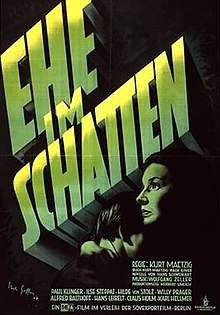Marriage in the Shadows
Ehe im Schatten (Marriage in the Shadows) is an East German film melodrama. Directed by Kurt Maetzig, it was released in 1947 by DEFA. The film was described as an "attempt to confront the German people about the morals of the past", being the first film to confront the people about the persecution of the Jews and the atrocities conducted during World War II.[1][2]
| Ehe im Schatten | |
|---|---|
 | |
| Directed by | Kurt Maetzig |
| Produced by | Georg Kiaup |
| Written by | Hans Scweikart |
| Starring |
|
| Music by | Wolfgang Zeller |
| Cinematography | Friedl Behn-Grund, Eugen Klagemann |
| Edited by | Alice Ludwig |
Production company | |
| Distributed by | Sovexport-Film |
Release date |
|
Running time | 104 minutes |
| Country | Soviet Occupation Zone |
| Language | German |
Plot
Actor Hans Wieland refuses to divorce his actress wife, Elisabeth, who is Jewish, even as extreme pressure is applied on him by the Nazi authorities. He even takes her to a premiere of one of his films where she is unwittingly introduced to a high Nazi Party official. Upon later discovering that the charming woman at the premiere was in fact Jewish, he orders her arrest. Hans Wieland is given an ultimatum by his former friend Herbert Blohm, now a Nazi official at the Reichskulturministerium (culture ministry), to save himself by divorcing his wife. Knowing that his wife will die in a concentration camp, Hans Wieland returns home and they drink poison in coffee whilst reciting the closing scene of Friedrich Schiller's tragic play Kabale und Liebe together.
The film ends with a dedication to the real-life actor Joachim Gottschalk who committed suicide with his Jewish wife Meta Wolff and their nine-year-old son Michael.
Cast
- Paul Klinger as Hans Wieland
- Ilse Steppat as Elisabeth
- Alfred Balthoff as Kurt Bernstein
- Claus Holm as Dr. Herbert Blohm
- Hans Leibelt as Fehrenbach
- Karl Hellmer as Gallenkamp
- Hilde von Stolz as Greta Koch
- Walter Werner as Mr. Hofbauer
- Karl Hannemann as Gestapo agent
- Elly Burgmer as aunt Olga
- Lothar Firmans as state secretary
Production
The screenplay was based on the life and suicide of actor Joachim Gottschalk and his family in 1941.[3][4] However, Kurt Maetzig said of the film, "almost everything in the film is based on what I myself, or my family and friends, have experienced."[2] Indeed, the character of Kurt Bernstein, portrayed by Alfred Balthoff, is strongly based on Maetzig.[2] Maetzig's mother had committed suicide to avoid being caught by the Gestapo.[2] It is Kurt Maetzig's first feature film as director.
Reception
Ehe im Schatten was the only film to be released simultaneously in all the sectors of occupied Berlin, on 3 October 1947, becoming the most successful film produced in the first post-war years and is widely considered one of the best German films of this period.[5] The picture sold 12,888,153 tickets.[6]
Maetzig and cinematographer Friedl Behn-Grund received the National Prize of East Germany Second Class for their work.[7] The director was also awarded the first ever Bambi Prize, in 1948.[2]
References
- Feinstein, Joshua (2002). The Triumph of the Ordinary: Depictions of Daily Life in the East German Cinema, 1949–1989. Chapel Hill: University of North Carolina Press. p. 26. ISBN 978-0-8078-5385-6.
- Allan, Seán; Sandford, John, eds. (1999). DEFA: East German cinema, 1946–1992. New York: Berghahn Books. p. 62. ISBN 978-1-57181-753-2.
- Bock, Hans-Michael; Bergfelder, Tim, eds. (2009). The Concise Cinegraph: Encyclopaedia of German Cinema. New York: Berghahn Books. p. 163. ISBN 978-1-57181-655-9.
- Costabile-Heming, Carol Anne; Halverson, Rachel J.; Foell, Kristie A., eds. (2001). Textual Responses to German Unification: Processing Historical and Social Change in Literature and Film. Berlin: Walter de Gruyter. p. 197. ISBN 978-3-11-017022-1.
- Liehm, Miera; Liehm, Antonin J. (1980). The Most Important Art: Soviet and Eastern European Film After 1945. Berkeley: University of California Press. p. 86. ISBN 978-0-520-04128-8.
- List of the 50 highest-grossing DEFA films.
- Kino- und Fernseh-Almanach. Henschelverlag Kunst und Gesellschaft. 1985. p. 7.